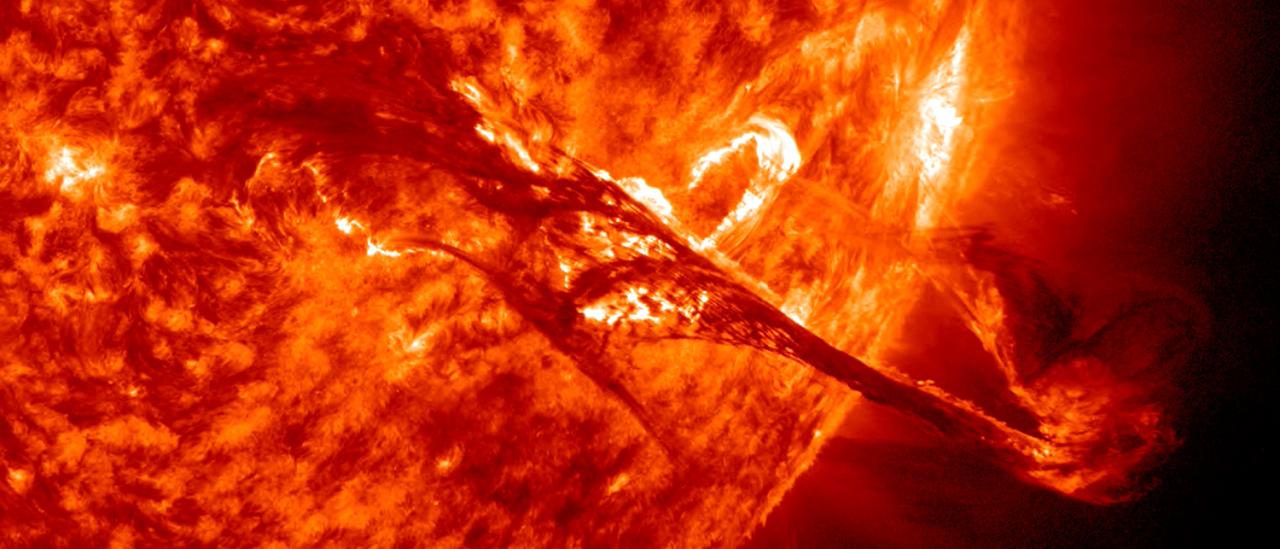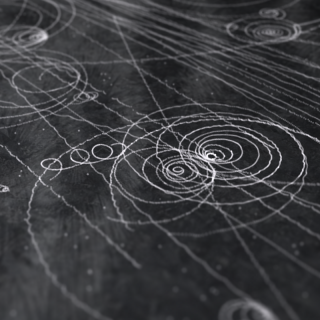General
Magnetic fields are at the base of star formation and stellar structure and evolution. When stars are born, magnetic fields brake the rotation during the collapse of the mollecular cloud. In the end of the life of a star, magnetic fields can play a key role in the form of the strong winds that lead to the last stages of stellar evolution. During the whole adult life of a star, magnetic fields are the origin of stellar activity. Our Sun has magnetic fields that give rise to such spectacular activity that impacts the climate on Earth. The magnetic activity in other stars is, in some cases, of orders of magnitude more intense than the solar one, influencing – often drastically – the transport of chemical species and angular momentum, as well as affecting the possible planetary systems around them.
The aim of this project is the study of the diverse manifestations of the magnetic field that can be observed in the solar atmosphere and in other stars. These include distinct structures as sunspots, weak quiet-sun fields or chromospheric and coronal features such as filaments and prominences. The following research topics have been gradually faced:
Solar magnetism
1. Structure and evolution of Sunspot magnetic fields.
2. Structure and evolution of quiet Sun magnetic fields.
3. Structure and evolution of the magnetism of the chromosphere and of chromospheric strcutures (promiences, spicules,...)
4. Structure and evolution or coronal loops.
5. Structure and evolution of the Sun's global field. Studies of the activity cycle.
6. Empirical study of propagation of magnetohydrodynamic waves in magnetic structures.
7. Empirical study of energy transfer mechanisms related with the heating of the external atmospheric layers.
8. Empirical study of the influence of partial ionisation in the dynamics of the solar atmosphere.
9. Participation in the European Solar Telescope project.
Stellar magnetism
1. Development of numerical tools to diagnose stellar magnetic fields, both in the surface and in the chromsphere.
2. Study of magnetic fields in stellar prominences.
3. Study of the role of magnetic fields in the late stages of stellar evolution.
Members
Results
- Spiral waves in sunspots: They have been interpreted as magnetoacoustic waves propagating from the interior to the atmosphere following the direction of the magnetic field. We have characterized the magnetic field topology, dismissing the twist of the field lines as the cause of the spiral shape (Felipe et al. 2019).
- Magnetic response to umbral flashes: Simultaneous spectropolarimetric observations of the chromospheric He I 10830 and Ca II 8542 lines have been used to estimate the fluctuations of the magnetic field associated to shock waves. The shocks cause expansion of the magnetic field lines (Houston et al. 2018, including A. Asensio Ramos).
Scientific activity
Related publications
-
Two-fluid simulations of waves in the solar chromosphere. I. Numerical code verification
Solar chromosphere consists of a partially ionized plasma, which makes modeling the solar chromosphere a particularly challenging numerical task. Here we numerically model chromospheric waves using a two-fluid approach with a newly developed numerical code. The code solves two-fluid equations of conservation of mass, momentum, and energy, together
Popescu Braileanu, B. et al.Advertised on:
72019 -
Stokes inversion based on convolutional neural networks
Context. Spectropolarimetric inversions are routinely used in the field of solar physics for the extraction of physical information from observations. The application to two-dimensional fields of view often requires the use of supercomputers with parallelized inversion codes. Even in this case, the computing time spent on the process is still very
Asensio Ramos, A. et al.Advertised on:
62019 -
Spectropolarimetric analysis of an active region filament. I. Magnetic and dynamical properties from single component inversions
Aims: The determination of the magnetic filed vector in solar filaments is made possible by interpreting the Hanle and Zeeman effects in suitable chromospheric spectral lines like those of the He I multiplet at 10 830 Å. We study the vector magnetic field of an active region filament (NOAA 12087). Methods: Spectropolarimetric data of this active
Díaz Baso, C. J. et al.Advertised on:
52019 -
Spectropolarimetric analysis of an active region filament.. II. Evidence of the limitations of a single-component model
Aims: Our aim is to demonstrate the limitations of using a single-component model to study the magnetic field of an active region filament. To do this, we analyzed the polarimetric signals of the He I 10830 Å multiplet, which were acquired with the infrared spectrograph GRIS of the GREGOR telescope (Tenerife, Spain). Methods: After a first analysis
Díaz Baso, C. J. et al.Advertised on:
52019 -
Inference of magnetic field strength and density from damped transverse coronal waves
A classic application of coronal seismology uses transverse oscillations of waveguides to obtain estimates of the magnetic field strength. The procedure requires information on the density of the structures. Often it ignores the damping of the oscillations. We computed marginal posteriors for parameters such as the waveguide density, the density
Arregui, I. et al.Advertised on:
52019 -
Chromospheric polarimetry through multiline observations of the 850 nm spectral region III: Chromospheric jets driven by twisted magnetic fields
We investigate the diagnostic potential of the spectral lines at 850 nm for understanding the magnetism of the lower atmosphere. For that purpose, we use a newly developed 3D simulation of a chromospheric jet to check the sensitivity of the spectral lines to this phenomenon as well as our ability to infer the atmospheric information through
Quintero Noda, C. et al.Advertised on:
72019 -
High-resolution spectroscopy of Boyajian's star during optical dimming events
Boyajian's star is an apparently normal main-sequence F-type star with a very unusual light curve. The dipping activity of the star, discovered during the Kepler mission, presents deep, asymmetric, and aperiodic events. Here we present high-resolution spectroscopic follow-up during some dimming events recorded post-Kepler observations, from ground
Martínez González, M. J. et al.Advertised on:
62019 -
Diagnostic potential of the Ca II 8542 Å line for solar filaments
Aims: In this study we explore the diagnostic potential of the chromospheric Ca II line at 8542 Å for studying the magnetic and dynamic properties of solar filaments. We have acquired high spatial resolution spectropolarimetric observations in the Ca II 8542 Å line using the CRISP instrument at the Swedish 1 m Solar Telescope. Methods: We used the
Díaz Baso, C. J. et al.Advertised on:
32019 -
Recent advancements in the EST project
The European Solar Telescope (EST) is a project of a new-generation solar telescope. It has a large aperture of 4 m, which is necessary for achieving high spatial and temporal resolution. The high polarimetric sensitivity of the EST will allow to measure the magnetic field in the solar atmosphere with unprecedented precision. Here, we summarise the
Jurčák, J.(Astronomical Institute of the Academy of Sciences, Fričova 298, 25165 Ondřejov, Czech Republic jurcak@asu.cas.cz) et al.Advertised on:
22019 -
Inferring physical parameters in solar prominence threads
Context. High resolution observations have permitted the resolution of solar prominences/filaments into sets of threads/fibrils. However, the values of the physical parameters of these threads and their structuring remain poorly constrained. Aims: We use prominence seismology techniques to analyse transverse oscillations in threads by comparing
Montes-Solís, M. et al.Advertised on:
22019 -
Spiral-shaped wavefronts in a sunspot umbra
Context. Solar active regions show a wide variety of oscillatory phenomena. The presence of the magnetic field leads to the appearance of several wave modes whose behavior is determined by the sunspot thermal and magnetic structure. Aims: We aim to study the relation between the umbral and penumbral waves observed at the high photosphere and the
Felipe, T. et al.Advertised on:
12019 -
Fast-to-Alfvén Mode Conversion Mediated by Hall Current. II. Application to the Solar Atmosphere
Coupling between fast magnetoacoustic and Alfvén waves can be observed in fully ionized plasmas mediated by stratification and 3D geometrical effects. In Paper I, Cally & Khomenko have shown that in a weakly ionized plasma, such as the solar photosphere and chromosphere, the Hall current introduces a new coupling mechanism. The present study
González-Morales, P. A. et al.Advertised on:
12019 -
On Kelvin-Helmholtz and parametric instabilities driven by coronal waves
The Kelvin-Helmholtz instability has been proposed as a mechanism to extract energy from magnetohydrodynamic (MHD) kink waves in flux tubes, and to drive dissipation of this wave energy through turbulence. It is therefore a potentially important process in heating the solar corona. However, it is unclear how the instability is influenced by the
Hillier, A. et al.Advertised on:
12019 -
No unique solution to the seismological problem of standing kink magnetohydrodynamic waves
The aim of this paper is to point out that the classic seismological problem using observations and theoretical expressions for the periods and damping times of transverse standing magnetohydrodynamic waves in coronal loops is better referred to as a reduced seismological problem. "Reduced" emphasises the fact that only a small number of
Arregui, I. et al.Advertised on:
22019 -
Real-time, multiframe, blind deconvolution of solar images
The quality of images of the Sun obtained from the ground are severely limited by the perturbing effect of the Earth's turbulent atmosphere. The post-facto correction of the images to compensate for the presence of the atmosphere require the combination of high-order adaptive optics techniques, fast measurements to freeze the turbulent atmosphere
Asensio Ramos, A. et al.Advertised on:
122018 -
Temporal and Spatial Scales for Coronal Heating by Alfvén Wave Dissipation in Transverse Loop Oscillations
Not Available
Terradas, Jaume et al.Advertised on:
102018 -
Three-dimensional simulations of solar magneto-convection including effects of partial ionization
In recent decades, REALISTIC three-dimensional radiative-magnetohydrodynamic simulations have become the dominant theoretical tool for understanding the complex interactions between the plasma and magnetic field on the Sun. Most of such simulations are based on approximations of magnetohydrodynamics, without directly considering the consequences of
Khomenko, E. et al.Advertised on:
102018 -
CLASP Constraints on the Magnetization and Geometrical Complexity of the Chromosphere-Corona Transition Region
The Chromospheric Lyman-Alpha Spectro-Polarimeter (CLASP) is a suborbital rocket experiment that on 2015 September 3 measured the linear polarization produced by scattering processes in the hydrogen Lyα line of the solar disk radiation. The line-center photons of this spectral line radiation mostly stem from the chromosphere-corona transition
Trujillo Bueno, J. et al.Advertised on:
102018 -
Study of the polarization produced by the Zeeman effect in the solar Mg I b lines
The next generation of solar observatories aim to understand the magnetism of the solar chromosphere. Therefore, it is crucial to understand the polarimetric signatures of chromospheric spectral lines. For this purpose, we here examine the suitability of the three Fraunhofer Mg I b1, b2, and b4 lines at 5183.6, 5172.7, and 5167.3 Å, respectively
Quintero Noda, C. et al.Advertised on:
122018 -
A Statistical Inference Method for Interpreting the CLASP Observations
On 2015 September 3, the Chromospheric Lyman-Alpha SpectroPolarimeter (CLASP) successfully measured the linear polarization produced by scattering processes in the hydrogen Lyα line of the solar disk radiation, revealing conspicuous spatial variations in the Q/I and U/I signals. Via the Hanle effect, the line-center Q/I and U/I amplitudes encode
Štěpán, J. et al.Advertised on:
92018



![Teacup in [O III] and CO(2-1) Supermassive black holes modify the distribution of molecular gas in the central regions of galaxies. Credit: HST and C. Ramos Almeida.](/sites/default/files/styles/crop_square_2_2_to_320px/public/images/project/teacup_english.001.jpeg?itok=dF4bDw-q)